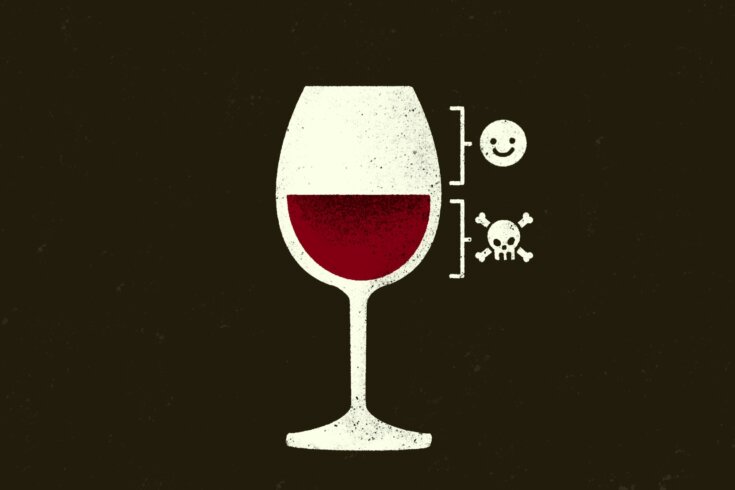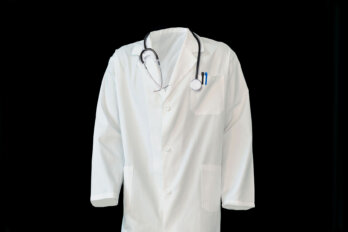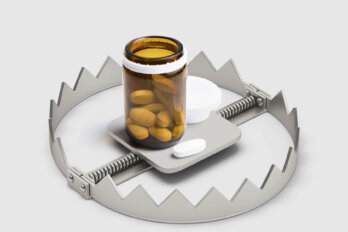Three weeks into January, just after Canada announced its new alcohol guidelines, a CHCH-TV reporter interviewed Beer Store goers in St. Catharines, Ontario, to ask them what they thought of the changes, which drastically reduced the recommended number of drinks per week from no more than ten for women and fifteen for men to a mere two (or, ideally, none at all).
The reporter stops a middle-aged man exuding dad rock energy on his way to buying an assortment of tall boys and asks how much he drinks each day. “Well, what day,” he shrugs. “On a regular day, I dunno, maybe a couple beers. Depends. Weekends, maybe, you know, five beers.” When he hears about the new recommendations, he looks baffled. “Two drinks a week!?” he says, with a look of disgust. “Well, that’s just not feasible. Not in this country.”
Much of society, both ancient and modern, has revolved around alcohol. One of the oldest known laws, dating back to circa 1770 BCE, during the Babylonian Empire, contains regulations for taverns (including a punishment of death by drowning for bartenders who served their customers smaller-than-advertised pours of beer), while ancient Greek and Roman literature details the copious amounts of wine consumed by gods and commoners alike. Stanford archaeologists have theorized that it was a thirst for beer—not a hunger for bread—that propelled the development of agriculture, which many consider to be the foundation of civilization itself. Today, in North America, turning the legal drinking age—and the blurry night that accompanies it—is seen as a rite of passage. Holidays, births, marriages, and celebrations of all kinds are marked by glasses filled with champagne, beer, or Scotch, as are our mundane rituals: a stressful workday, a sunny afternoon, or a date. So while it’s easy to recommend that we reconsider our relationship with alcohol, actually getting people to change their habits—especially ones that are so deeply ingrained—may prove to be a much slower process.
Whether it’s feasible or not to cut back on booze, the reasons for doing so aren’t entirely unconvincing. The old guidelines for safe consumption, released in 2011, were based on outdated research, some of which went as far as to claim that drinking in moderation offered protection against certain cardiovascular diseases. (For proof, look no further than the French, who drink wine in abundance yet tend to live longer than the average North American, according to commonly cited and now debunked research from the ’80s.) But over the past decade, evidence of an alternative narrative has emerged.
Alcohol is a known carcinogen. When you drink a pint of beer or a glass of whisky, your liver converts the alcohol into a toxic chemical called acetaldehyde, then breaks that down into a less toxic compound called acetate. The entire process of trying to rid your system of an evening’s libations sends your body’s functions into overdrive—which is why it isn’t unusual to wake up the next day feeling like a groggy, hollow version of your former self. While the short-term misery that accompanies a hangover does subside, a buildup of acetaldehyde in the body can lead to DNA damage, and since DNA contains the instruction manual for normal cell function, any changes to it can prevent your body from being able to repair itself, putting you at a greater risk of cancer, stroke, and a handful of other diseases. It’s like trying to put together an Ikea wardrobe without all of the illustrations: you could wing it, but a few forgotten screws may one day cause the whole thing to collapse.
According to the new guidelines, those who consume between three and six standard drinks a week expose themselves to a 1 in 100 chance of premature death, with an increasingly higher risk level for those who consume more than six per week. That may not seem high, but compared to risk thresholds for other voluntary activities like smoking, where the risk is 1 in 1,000, drinking can be significantly more dangerous.
“The higher threshold that has been historically accepted and used for alcohol comes from the cultural, social, and economic attachment that we have to it as a Western culture,” says Peter Butt, an associate professor in the University of Saskatchewan’s department of family medicine who worked on the new guidelines. “We’ve developed this mythology around it, where all of these things are seen as beneficial . . . but we’ve overlooked the health impacts.”
To draw their conclusions, the researchers who worked on the new recommendations reviewed just under 6,000 studies on the health effects of alcohol, eventually selecting sixteen deemed to be the most eligible based on the project’s research questions and needs for mathematical modelling. And while the methodology, at least from a scientific perspective, seems sound, the guidelines’ critics aren’t limited to distraught Beer Store goers. One of the most vocal skeptics is Dan Malleck, a professor in the Department of Health Sciences at Brock University who studies drug and alcohol regulation and policy. In an op-ed for the Globe and Mail, he argued that the report examined drinking through a purely medical lens, failing to account for the positive effects drinking can have on a person’s life. What about its ability to help us relax? Or to bring a group of people together? Research shows that such positive effects can improve long-term health outcomes too.
During our conversation, Butt is quick to emphasize that the point of the guidelines is harm reduction, not abstinence. “Canadians didn’t want to be told what to do. They want to have all the information so that they can make decisions for themselves,” he says. “This isn’t about prohibition; this is about drinking less.”
At first glance, Hekate in New York City’s East Village looks like most other casual bars. Popular drinks are spelled out on the wall in chalk: a spring spritz, a jalapeno margarita, a small selection of craft beers. A group of friends clink glasses; a couple on a first date share sips of cocktails, passing their drinks back and forth; tourists wander in off the street, looking to take a seat after a long day of sightseeing. But despite the collection of colourful bottles and cans displayed at the bar, nothing here contains any alcohol.
Its owner, Abby Ehmann—who’s lived in New York for nearly four decades—opened Hekate’s doors in 2022. A bar owner since 2016, she had been toying with the idea of starting a second business for a few years when she found a vacant storefront directly across the street from her bar Lucky (which does serve alcohol).
Lucky has its fair share of regulars, but that came with its own set of problems. “My number one customer had a stroke, and his doctor told him, ‘Maybe you shouldn’t be drinking so much,’” Ehmann says. “I had created a place that people wanted to come to every night, but that also resulted in them drinking every night. So I thought, ‘How can I create the same sort of ambiance and community but without alcohol?’”
While January is a notoriously slow month for hospitality, Ehmann says business at Hekate was “off the charts”—so much so that she ran out of some of the non-alcoholic spirits. Her bar is one of the few fully alcohol-free ones in New York, but it’s part of a small wave of similar establishments that have popped up in Dublin, Melbourne, Austin, and Toronto. Non-alcoholic beer, wine, and spirit sales in the US still make up only a tiny fraction of the market of alcohol sales (less than 1 percent), but these drinks are growing in popularity. According to data from NielsenIQ, between 2021 and 2022, sales of non-alcoholic wine increased 23.2 percent, while those of non-alcoholic spirits increased 88.4 percent—which might help explain why it’s becoming far more common to see mocktails or low-alcohol cocktails listed on standard-fare bar menus. There’s also something to be said about the quality of the products available today. About a decade ago, boozeless options were mostly limited to juices and sodas. Now, there are easily sourced artisanal alternatives for every vice—be it gin, bourbon, or rum—and they offer flavour profiles similar to those of their alcoholic counterparts.
Drinking has already been on the decline—albeit slowly—for decades. A 2018 survey by Berenberg Research found that respondents in their teens and early twenties were drinking 20 percent less than millennials did at that same age. Other research has found that millennials also drink less than Gen Xers and boomers. Currently, 22 percent of people in Canada don’t drink at all, while just over 20 percent consider themselves to be light drinkers, consuming less than three standard alcoholic beverages per week. That means more than half the population is drinking at a level that would place them in the moderate- or high-risk categories of the new guidelines.
And it’s not only that younger generations are drinking less. Some aren’t drinking at all. A 2019 study in England found that about a quarter of sixteen-to-twenty-four-year-olds were totally sober. Even among those who haven’t given up booze, the practice of “mindful drinking,” or developing a healthier relationship with alcohol, is becoming far more common. The reasons for this vary, but according to one BBC article, it could be because the way young people relax is changing too. Gen Z has been dubbed the “always on” generation. Their unavoidable tether to smartphones means they tend to be more prone to switching off in their spare time than going out and getting wasted (though other research suggests they’re more likely to gravitate toward cannabis and magic mushrooms).
“In the mid to late 2000s, getting drunk and binge drinking was a way friendships were formed and solidified—even experiencing the negative effects together was a key part of making and sustaining friends in adolescence and early adulthood,” John Holmes, professor of alcohol policy at the University of Sheffield, told the BBC. “But Gen Zers are more likely to see drunkenness as unpleasant, uncool, or uninteresting.”
The shift in attitude isn’t entirely dissimilar to how most millennials interact with cigarettes. Once considered to be cool (not to mention cheap), many governments were able to change the public image of tobacco consumption by introducing educational campaigns, tightening controls around sales, and limiting smoke-friendly spaces. Should they try to do the same with alcohol too?
According to Edward Slingerland, a philosophy professor at the University of British Columbia and the author of Drunk: How We Sipped, Danced, and Stumbled Our Way to Civilization, the answer is a bit more nuanced. While Slingerland, himself a lover of negronis, acknowledges that alcohol can be a dangerous substance, he, like Malleck, says that the new recommendations don’t account for the creative and hedonistic benefits that a few drinks here and there can provide. In Drunk, he argues that throughout the entirety of history, alcohol has been used as a social lubricant, enabling everything from creativity to peacekeeping.
“Around the world, whenever you have potentially hostile people who need to come to an agreement, or just strangers who need to get along, alcohol comes out,” he says. “It helps with social bonding and getting people past mutual distrust or awkwardness—which humans need because we have a lot of primate instincts.”
Unlike nicotine, which can be more easily replaced by things like coffee, there’s no readily available substitute that offers the same functional effects as booze. Because alcohol is a depressant, having a glass of wine or two can slow down processes in our central nervous system, making us feel more at ease (at least temporarily). Something like cannabis, on the other hand, is harder to dose and affects everyone differently. “Imagine going on a date to a bar where we’re smoking pot and you get really happy and want to talk about philosophy while I get paranoid and then fall asleep at the table,” says Slingerland. “There’s probably not going to be a second date.”
Slingerland adds that, historically, alcohol consumption has always been regulated, albeit informally. At ancient Greek symposiums, guests weren’t allowed to drink until the host passed the wine around the table. Similarly, attendees of banquets in traditional China had to wait until a toast was made before they could start sipping. Even today, those who drink at bars with friends tend to order in rounds to maintain a pace with each other. In every scenario, alcohol was meant to be enjoyed in the company of others—not for the purpose of getting sloshed alone.
But having private access to liquor at home—especially at the peak of the pandemic, when excessive drinking increased by 21 percent, according to one study from the Massachusetts General Hospital, which used data from a national survey of American adults about their drinking habits—makes regulation much more difficult. “Now, I can call up the local liquor store and have them deliver a case of tequila to my house,” says Slingerland. “Then I can drink as much of it as I want without anyone stopping me. That’s when it becomes harder to control our consumption.”
It’s clear that some of the more recent rituals we’ve developed around drinking haven’t been for the better, but Slingerland is optimistic that we can change that trajectory. “We have a sense that alcohol is more dangerous than it used to be—and that maybe we’re not drinking healthily. But humans are very clever, and we’re good at coming up with new ways to try to get a handle on things.” Perhaps that’s where the real change needs to occur: how we drink, how often we drink, in what quantities, and the accompanying social circumstances that steer how we imbibe. The way we drink has evolved over centuries. Maybe it’s time to embrace the next evolution.





